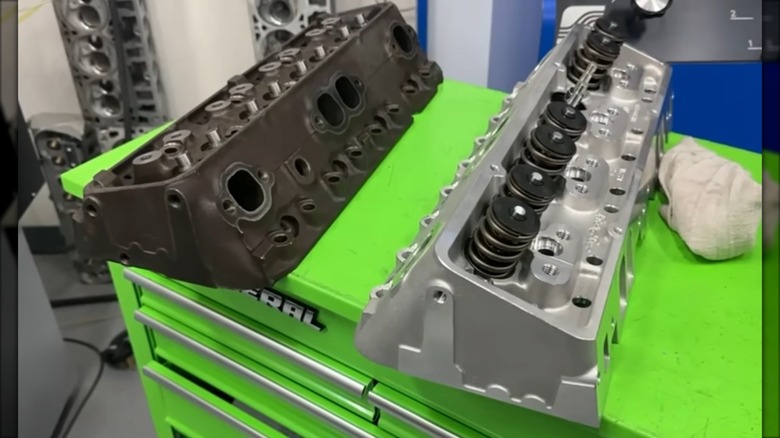What Are Chevy Double Hump Heads? (And How To Identify Them)
I worked as a machinist in an automotive machine shop in the early 1980s before my career took me into the aerospace sector. The shop's high volume of mundane engine rebuilds and turning brake drums and rotors paid the bills. However, the occasional high-performance small block Chevrolet 327 or 350 engine-build for use on local race tracks or simply hot rodding around town made leaving the low-paying job difficult.
Those builds most often consisted of over-bored four-bolt main engine blocks, forged crankshafts, aggressive camshafts, and performance-oriented double hump cast-iron cylinder heads with fresh valve jobs. Other Chevy cylinder head castings would do in a pinch, but the double hump, sometimes called camel hump, castings were the holy grail of Chevy small block cylinder heads desired by most people.
Small block Chevy (SBC) cylinder heads are identified by raised casting marks located at the ends of the heads. While there are several head casting variations with different marks, the double hump head is identified by variations of raised humps situated on top, and on each end, of a line or rectangle.
What makes Chevy double hump heads special?
Chevrolet began using the double hump cylinder head design on its small block engines in 1962. While they weren't included on every Chevy with a small block V8, they were common enough to ensure a plentiful supply of the original cast-iron version even today. If you can't find any original double hump heads, the aftermarket offers cast aluminum versions as well.
Double hump heads performed well straight from the factory. Their free-flowing nature made them a good fit for the Chevy muscle cars that carried them. The list of performance-oriented Chevys equipped with double hump heads includes familiar names like Corvette and Camaro, although other cars equipped with the best Chevy 302, 327, and 350 cubic-inch V8 engines had them too.
Different double hump casting numbers, the most notable ending in 186, 291, and 462, offered a variety of machined external bosses with and without threaded holes used for mounting accessories such as temperature-sending units, emissions controls, and larger water pumps. Most double hump heads housed intake and exhaust valve diameters measuring 1.94 and 1.50 inches, respectively. The best versions, "fuelies" from their use on fuel-injected Corvettes, had 2.02-inch intake and 1.60-inch exhaust valves.
Another advantage that double hump heads had over other SBC heads was smaller combustion chambers. Fuelie head combustion chambers measured as small as 62cc, while standard SBC heads ranged up to 76cc. Smaller combustion chamber sizes allow higher compression ratios without the need for swapping from flat-top to domed pistons.
Are aftermarket double hump heads better than the original versions?
High performance cylinder heads allow the engine to breathe easier with free-flowing ports and large valves. While aftermarket aluminum heads are lighter weight than cast-iron versions, we'll focus on the volume of air each one can flow through. Although the original cast-iron double hump heads received special attention at the factory where they were cast and during assembly, they were still part of a mass-produced engine build. As such, allotting excessive time to porting and polishing surfaces in the valve throats or intake and exhaust port runners cut into Chevrolet's profits. Aftermarket heads must meet higher standards in order to compete in the marketplace, and they have the benefit of advanced processes like CNC porting.
An Eric Weingartner YouTube video shows a head-to-head comparison of a lightly-ported 186-casting 64cc head to a Trick Flow aluminum head with 60cc combustion chambers. For reference, both heads are fitted with 2.02-inch intake and 1.60-inch exhaust valves, an upgrade for the 186 head. On a flow bench used to measure airflow through the heads in cubic feet per minute (CFM), the 186 head had a peak flow of 228.8 CFM through the intake compared to the aftermarket's 249.6 CFM. On the exhaust side, the 186 peaked at 178.8 CFM, while the Trick Flow aluminum head topped out at 187.4 CFM.
Ultimately, the Trick Flow heads are better with smaller combustion chambers and flow more air. However, the 186 had slightly higher exhaust flow until the valve neared its full-open position.


